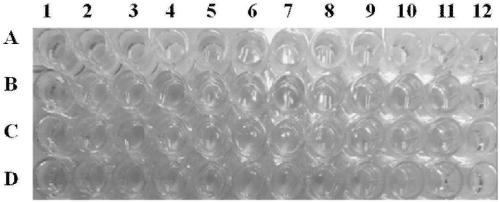Aspergillus versicolor ZJB16085 and application of aspergillus versicolor to synthesis of R-2-(4-hydroxyphenoxy) propionic acid
A technology of ZJB16085, hydroxyphenoxy, applied in the field of Aspergillus versicolor by transforming R-2 phenoxypropionic acid into R-2-propionic acid
- Summary
- Abstract
- Description
- Claims
- Application Information
AI Technical Summary
Problems solved by technology
Method used
Image
Examples
Embodiment 1
[0025] Embodiment 1: Screening of bacterial strain ZJB16085
[0026] (1) Sampling from the soil in many planting areas on the campus of Zhejiang University of Technology, each weighed 1g of soil samples (wet weight), made a suspension with 9mL of 0.9% normal saline, drew 1mL and inoculated it in the In a 250mL Erlenmeyer flask with 50mL enrichment medium containing 10g / L R-2-phenoxypropionic acid, cultivate on a shaker at 28°C and 150rpm for 1-2d for the first enrichment culture; take 1mL of the first The second enrichment culture was carried out in the fresh enrichment medium containing 10g / L R-2-phenoxypropionic acid for the second enrichment culture under the same conditions. The bacterial solution of the second enrichment culture was serially diluted, and 100 μL was taken to dilute 10 3 and 10 5 The diluted solution was spread on the screening medium plate, and cultured in a constant temperature incubator at 28°C for 3-4d. Use a sterile toothpick to pick a single colony...
Embodiment 2
[0036] Embodiment 2: identification of bacterial strain ZJB16085
[0037] (1) Colony morphology observation
[0038] Use an inoculation needle to pick a small amount of spores of the strains preserved on the slant, streak on the PDA plate, and incubate at 28°C for about 7 days. The single colony morphology is shown in image 3 . The diameter of the colony is about 1.8cm, the colony is loose, the hyphae are short, the texture is fluffy, the middle is raised, and the shape is concentric. The color gradually changes from dark green to cyan, and the outermost part is white. The back edge of the colony is white, and the middle gradually turns pale yellow.
[0039] (2) Observation of mycelium morphology
[0040] Spread a piece of circular filter paper on the bottom of a petri dish with a diameter of 9.0 cm, put a U-shaped glass rod on it, put a clean glass slide and two coverslips on the glass rod, cover the dish, and inoculate after sterilization , cultivated at 28°C for about ...
Embodiment 3
[0046] Example 3: Aspergillus versicolor CCTCC No: M 2018408 fermented and transformed R-2-phenoxypropionic acid to produce R-2-(4-hydroxyphenoxy)propionic acid
[0047] Aspergillus versicolor CCTCC NO:M 2018408 was inoculated into the slant medium, and cultured statically at 28°C for 6-7d to obtain slant strains. Pick the bacterium from the slope and inoculate it into a 250mL shake flask filled with 50mL of seed medium, and culture at 28°C and 150-200rpm for 2-3d to obtain a seed liquid. The seed solution was inoculated into a 250mL shake flask containing 50mL of fermentation transformation medium with an inoculum volume concentration of 3%, and cultivated at 28°C and 150-200rpm for 2-3d until the wet cell content in the fermentation broth reached 20g / L, and added the final R-2 phenoxypropionic acid at a concentration of 10g / L, continued to cultivate at 28°C and 150-200rpm for 6-7d. The reaction solution was centrifuged at 10000rpm for 10min, and the supernatant was filtered...
PUM
| Property | Measurement | Unit |
|---|---|---|
| diameter | aaaaa | aaaaa |
Abstract
Description
Claims
Application Information
 Login to View More
Login to View More - R&D
- Intellectual Property
- Life Sciences
- Materials
- Tech Scout
- Unparalleled Data Quality
- Higher Quality Content
- 60% Fewer Hallucinations
Browse by: Latest US Patents, China's latest patents, Technical Efficacy Thesaurus, Application Domain, Technology Topic, Popular Technical Reports.
© 2025 PatSnap. All rights reserved.Legal|Privacy policy|Modern Slavery Act Transparency Statement|Sitemap|About US| Contact US: help@patsnap.com



